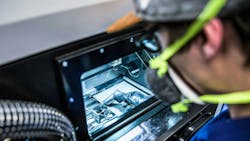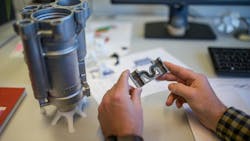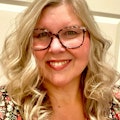3D Printed Flex Shaft Brings New Design Opportunities to Aviation
Liebherr-Aerospace has taken the next step in its 3D printing journey by producing a flex shaft for aviation applications using additive layer manufacturing (ALM). This allows for the creation of a less complex component, helping to reduce wear parts and weight.
Airbus and the European Union Aviation Safety Agency (EASA) have approved the flex shaft, made of titanium powder, to enter series production. It will be integrated into the differential gearbox of the flap system that is part of Airbus’ A350 high lift system where it will be used to transmit rotary movement to a position sensor to help compensate for potential angle and axis misalignment between the gearbox and sensor.
“Liebherr-Aerospace Lindenberg GmbH has been certified by the German authorities (LBA) for additive manufacturing since 2017 and has produced parts in series production since 2019,” said Svenja Pestotnik, head of additive manufacturing at Liebherr-Aerospace Lindenberg GmbH. “The approval of the flex shaft shows that AM (additive manufacturing) is a reliable technology that enables designs which improve the sustainability of current and future aircraft.”
3D Printing Provides a Flex (Shaft) for the Aviation Sector
Traditionally, the flex shaft is a component requiring seven separate parts to be assembled through welding, gluing and other labor-intensive processes. Using ALM instead allows Liebherr-Aerospace to produce a single piece with an integrated mechanism, reducing complexity and labor.
“The flex shaft is a perfect example [of] how additive manufacturing can integrate a complex assembly into one unified component,” Pestotnik said. “The additively manufactured part is manufactured as a single component with an integrated mechanism. This saves on manual labor, stock keeping of individual parts and reduces lead-times significantly.”
With fewer parts contained in the final component assembly, the number of potential wear points is reduced, which helps to improve reliability while also reducing the need for maintenance. Creation of a single, more integrated flex shaft allows for a lighter weight component as well, leading to weight reductions for the application into which the flex shaft will be installed.
Both aspects can greatly benefit a cost-sensitive industry like aviation. Less time and money will be spent on unplanned downtime and weight reductions are directly correlated to reduced fuel consumption which not only lowers operating costs but emissions as well.
The 3D printed flex shaft is more complex than those previously manufactured by Liebherr-Aerospace using additive manufacturing. Through the success of this project the company is able to show what is possible when using this technology for highly integrated systems.
“The flex shaft demonstrates how different functions can be efficiently integrated into one component. Extensive tests showed the reliability of this novel design approach, which opens the door for more complex and critical applications of AM in the future,” Pestotnik said.
Using additive manufacturing in the aviation industry requires setting up a reliable and repeatable process, according to Pestotnik. “This includes all steps of the process chain starting from the procurement of the powder to manufacturing, heat treatment and quality control,” she said.
Because AM is a rather new technology, she noted that many of these processes had to be developed from the ground up, “yet always in collaboration with our customers, partners and the authorities. During the development of the flex shaft, a collaborative effort with Liebherr’s partner for computer tomography inspection enabled the successful certification by LBA,” Pestotnik said.
READ MORE: Additive Manufacturing Brings Opportunities to Improve Component Design and Production
On the Horizon: A Sustainable AM Future
Looking ahead, Pestotnik said that the company “will use its constantly growing and evolving knowledge and experience in additive manufacturing to develop the actuation systems and aircraft components of the future, gaining a significant advantage over competitors in that field.” She added that Liebherr will continue to invest in AM to provide more economic and ecologic components in the future ranging over their whole product portfolio.
And when asked how additively manufacturing these components aligns with the sustainability goals of the aviation industry, particularly in terms of material efficiency and waste reduction, Pestotnik said, “AM is an enabler for future aircraft with compact and efficient part designs that would be impossible to produce with conventional manufacturing techniques. Since AM parts usually require minimal rework, the buy-to-fly ratio is tremendously improved over other manufacturing techniques, saving valuable resources and energy.”
READ MORE: Manufacturers Researching More Sustainable Component Production Process
Liebherr-Aerospace’s 3D Printing Journey
In March 2017, the company, along with aircraft maker Airbus, was the first to successfully fly a 3D-printed spoiler actuator valve block on a flight test A380 aircraft. Since then, the company has supplied numerous on-board 3D printed parts for a range of applications—some are prototypes like the A380 flight control actuator and others are serial production parts like cabin air distribution ducting parts.
This latest venture into additive manufacturing comes just 5 years after the serial production of 3D-printed parts with the introduction of a printed proximity sensor bracket for the A350 nose landing gear. The company reports this bracket was the first-ever introduced Airbus system part qualified for titanium ALM.
When asked about the evolution for the proximity sensor bracket to the more complex flex shaft and what the progression signifies for the company’s future endeavors in additive manufacturing, Pestotnik said that Liebherr’s approach has always been to tackle one challenge at a time. “Starting with simple parts and then progressing to more complex and critical parts allowed us to establish an industrialization process early on and gain trust and experience at an early stage,” she said.
About the Author
Sharon Spielman
Technical Editor, Machine Design and Power & Motion
Sharon Spielman is a technical editor for Power & Motion and its affiliate publication Machine Design. As technical editor, her beat includes 3D printing/CAD; mechanical and motion systems, with an emphasis on pneumatics and linear motion; automation; robotics; and AR/VR.
Sharon has more than three decades of experience as a writer and editor for a range of B2B brands, including those that cover electrical design and manufacturing; interconnection technology; food and beverage manufacturing; process heating and cooling; finishing; and package converting.




